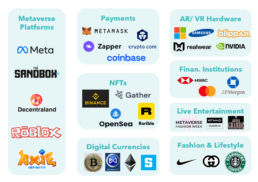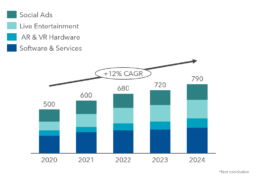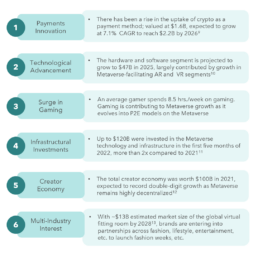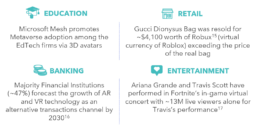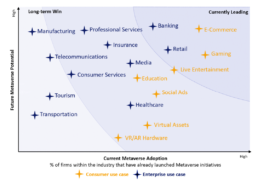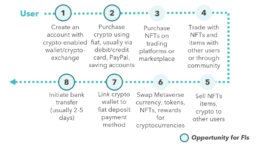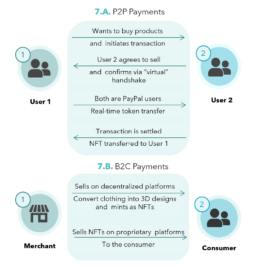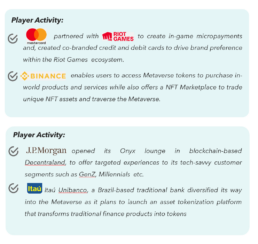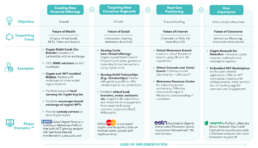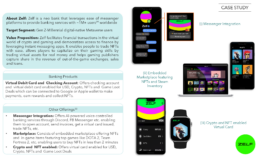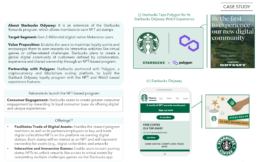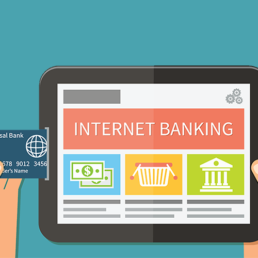While it is still in its infancy, several technology leaders predict that the Metaverse has the potential to be the next big innovation in the digital economy. The use-cases of the Metaverse are expanding, with an increasing number of people making investments in the Metaverse such as buying virtual land, gold, digital assets, etc. As Metaverse begins to define the future of the online world, financial institutions have the opportunity to embed themselves within this new platform, engage its users, and capture new payment flows.
To start, it is important to review the Metaverse’s interactions with financial institutions. While a few early use cases such as marketing, gaming, social retail and live events have gained momentum on the Metaverse, the mainstream use cases in healthcare, education, training etc. are likely to define the future of the metaverse.
What is the Metaverse?
Exhibit 1. Examples of Key Metaverse Players (1)
Metaverse is essentially a place where users can create electronic versions of themselves to interact with others – be it for work, leisure or socializing.
Metaverse users are interested in using the platform to virtually explore new destinations, attend live concerts of their favorite artist, meet up with friends and play the latest games, buy popular digital artworks, etc. It is predicted that the opportunities in this space will be worth $5 trillion by 2030(2), with 95% of business leaders (3) expecting the Metaverse to have a positive impact on their industries.
With this surge in demand, several well-known industry leaders are using the Metaverse to engage with various audiences and deliver personalized consumer interactions. This virtual world is creating new channels for businesses to deliver immersive experiences across shopping, sports, games etc., and is soon expected to expand to traditionally physical industries like healthcare and manufacturing. Some of the leading financial institutions which recently entered the Metaverse include:
- JP Morgan is the first bank to enter the metaverse with a virtual ‘Onyx lounge’ and partnered with Decentraland, – a Metaverse platform
- Nasdaq held its first opening bell event in the Metaverse in mid-2022; exhibiting how Wall Street is capitalizing on the market potential
Metaverse Ecosystem and Virtual Worlds
The Metaverse ecosystem is complex, composed of multiple layers and building blocks. The infrastructure needs to process transactions on the Metaverse are nuanced with newer tech stacks that are continuously evolving and changing. Some of the more common requirements include 3D infrastructure, Augmented/ Virtual Reality, and can benefit from blockchain, Web3.0 etc. Overall, there are two main types of virtual worlds worth exploring for financial institutions:
- Traditional Metaverse: Virtual space controlled by a centralized organization without the use blockchain or Web3.0. Trading on these platforms is close-looped and facilitated by non-crypto digital tokens / coins that need to be purchased via fiat. E.g., Fortnite, Roblox use proprietary digital currency and coins such as Vroblox
- Blockchain Metaverse: These platforms create a complete digital economic environment in which users monetize their acquisitions and creations. It works on blockchain infrastructure & crypto payments.
- Centralized: While users can monetize their creations & transactions independently, user data is held with a third-party organization. Users need to buy into publicly traded cryptocurrencies to trade. For e.g., Meta Metaverse that the Meta group is building or Earth2 which use cryptocurrencies such as BTC, ETH for purchases
- Decentralized: Virtual spaces based on Decentralized Autonomous Organization (DAO). In these platforms, decision making power doesn’t lie with a central organization. Earning mechanisms in NFTs such as Play to earn, are the most visible on these platforms. These use crypto-backed digital currencies specific to these platforms which require an additional buy-in ramp. For e.g., Axie Infinity and The Sandbox which use proprietary crypto backed currencies like AXS, SAND that can be bought using BTC, ETH etc.
Metaverse is Gaining Traction and is Here to Stay
The Metaverse market is estimated to grow ~$430B by 2027, at a ~40% CAGR (4). After the transformation from print to digital, the technology evolution is all set to take the leap from Web 2.0 to the Metaverse (Web 3.0).
Businesses have started to crowd the Metaverse space with investments, such as Nike, PwC and Gucci that have stakes on Decentraland and The Sandbox. Even tech giants including Google, Amazon, Meta and Microsoft are investing heavily in the Metaverse space to create their own platforms.
The Metaverse economy has the potential to generate ~$790B revenue in 2024 (5) with its growing revenue segments as discussed below:
- Social Ads: The social ads in the Metaverse deliver an immersive marketing experience. Metaverse provides advertisers the opportunity to use VR billboards to showcase their products
- AR and VR Hardware: As the number of people venturing into the Metaverse grows, so does the hardware sales. In 2022, the number of AR/VR headsets sold is expected to reach ~14M (7)
Exhibit 2. Popular Metaverse Revenue Segments* (in US$ B)6
Exhibit 3. What is driving growth of the Metaverse?
These growth drivers, with proven use cases and business outcomes, are just the beginning of the likely disruption. Metaverse has been gaining the most traction in the gaming industry, specifically video games, which has been an innovator in experience and technology for many years. Gaming is leading the way with ~70% of Roblox’s ~50M daily users who are below the age group of 16yrs (14), which could signal the coming of a whole new generation of Metaverse natives. Metaverse is expected to define the future of gaming and expand the use-case to social commerce, online concerts, retail, fashion, etc.
New business models are also emerging with these initiatives, such as restaurants that only serve diners who own specific access oriented NFTs.
Exhibit 4. Metaverse Example Use Cases
Exhibit 5. Metaverse Opportunities for Various Industries (18)
In the retail industry, organizations are trying to extract value from a range of use cases around the Metaverse (for instance, NIKE is selling branded NFTs or Forever21 is opening a virtual storefront in the Metaverse). Metaverse application has extended beyond entertainment to traditional sectors like healthcare, which is an estimated ~$7B market in 2021 and is expected to grow with more than 30% CAGR till 2030 (19).
Given the wide use cases across different industries, it is important to understand that the Metaverse is creating new channels and payment flows for financial institutions to tap onto. JP Morgan is one of the many financial institutions which entered the space via launch of Metaverse virtual lounge in Decentraland.
Payments in the Metaverse
Payments in the Metaverse vary from the physical world in terms of currencies, methods, and infrastructure. Metaverse users need to buy into crypto or digital currencies by using fiat currency; further used to purchase digital assets, NFTs in-whole or in-part. Financial Institutions processing non-fiat transactions earn fees by crypto processing & NFT Gas fees. Metaverse users prefer debit/ credit cards and digital wallets to make crypto purchases due to easy integrations and wide acceptance. Metaverse payments are not as frictionless as physical world as they involve crypto on-ramps and off-ramps which sometimes span across days due to the interaction of multiple players. In order to better understand the current state of payments in the Metaverse, it is important to acknowledge interaction between digital assets, digital currencies and fiat incorporates the Metaverse Payments Ecosystem.
- Digital Assets: Metaverse assets can be anything from digital art, virtual goods or experiences minted into secure NFTs stored on the Metaverse blockchain. These NFTs can be sold for cryptocurrencies to purchase other Metaverse assets or make P2P transfers.
- Crypto/ Digital Currencies: Cryptocurrencies and other blockchain-based digital currencies facilitate transactions on the Metaverse at zero cost. These are used to purchase digital assets or make P2P transfers. DeFI facilitates direct exchange without routing via a centralized authority.
- Fiat Money: While direct usage of fiat currency on the Metaverse stays limited to traditional centralized platforms such as Fortnite – it is widely used to purchase crypto/ digital currencies to facilitate transactions on blockchain Metaverses. Traditional fiat currency payment systems such as online wallets like PayPal and Stripe, as well as debit/ credit cards, will be present in the Metaverse for the foreseeable future. While cryptocurrency seems like the natural fit for Metaverse transactions, not all users are willing to adopt crypto as their preferred payment method, especially given the current turmoil in crypto.
Centralized Metaverses have a relatively straightforward user payments journeys due to the use of fiat currencies and traditional payment methods. However, decentralized Metaverses give rise to multiple payment flows beyond the traditional B2C interactions, such as P2P. A typical decentralized Metaverse user would use fiat money to buy crypto to facilitate transactions on the Metaverse.
The Metaverse ecosystem is complex with multiple platforms, and is primarily monetized through P2E games, NFTs, and retail. Metaverse space is still being defined, but gaming and P2E monetization opportunities are a driving growth of investments and adoption.
As the Metaverse continues to build on existing technologies, new payment mechanisms are being developed to accommodate the needs of this growing community. A typical user journey (Exhibit 6) on the Metaverse involves multiple rounds of buy-ins into mainstream cryptocurrencies such as BTC, ETH etc., which are further used to buy into a close-looped Metaverse currency such as Axie Infinity and Decentraland. Some of the key payment rails for the Metaverse include traditional payment players (e.g., PayPal) that facilitate crypto buy-ins through wallets, Crypto exchanges (e.g., Binance) that enable purchase of crypto which used to make in-gamer purchases, NFTs etc., Crypto/NFT Wallets (e.g., Metamask), Fiat on/off ramps (e.g., Simplex) and Crypto Gateway (e.g., BitPay).
Exhibit 6. Example User Journey in Decentralized Metaverse (20)
These payment rails offer an opportunity for Financial Institutions to integrate their wallets to support crypto or partner with crypto exchanges. While Metaverse presents massive potential, it comes with its own set of risks that businesses must be wary of, the biggest one being the risk of fraud as there are limited security measures to prevent cybercrime on Web 3.0 such as false chargebacks, data theft etc. For Financial Institutions, apart from the Metaverse presenting a huge opportunity in terms of revenue and customer interaction, the Metaverse also presents adjacent opportunities to cross-sell existing financial products such as insurance, crypto investments and investments. With these new payment flows, digital banking will take on a whole new meaning in the Metaverse. To capitalize on this opportunity, several Financial Institutions have already started to initiate Metaverse strategies. For instance, Bank of America is first in the industry to launch a virtual reality training program in ~4300 financial centers (22).
Capturing payment flows is just one of the many reasons for financial institutions to be interested in the Metaverse in the first place. Going into the Metaverse can be part of a financial institution’s long-term strategy, to be more digital native and to cater to younger consumers along with other strategic rational as discussed below.
Exhibit 7. Payments Use Case in the Metaverse (21)
Importance of Metaverse for Financial Institutions
- Creating New Financial Offerings: There is a high potential for innovative products and services involving digital payments and assets. Traditional payment flows are starting to migrate into new innovative flows such as NFT-based cards, crypto wallets, Metaverse tokens, etc. Financial institutions can leverage the crypto and NFT-enabled digital wallets which allow users to manage, buy, sell, and trade crypto currencies.
-
Targeting New Consumer Segments: Metaverse for children and young adults (ages 10-20) is the fastest-growing segment with gaming companies looking to target and monetize younger generations. Metaverse is the key to capture younger segments (Gen Z) as the younger population spends the maximum time playing games and interacting in the virtual worlds. Generation Z and millennials currently spend ~5hrs per day in the Metaverse. To increase presence in Metaverse, financial institutions should aim to position themselves as modern Financial Institutions and attract the gamers segment.
Exhibit 8. Importance of Metaverse for FIs
Player Activity
- Next Gen Positioning: New dimension of interaction and engagement is being developed in the Metaverse as creators will be able to create virtual avatars, capable to interact in real-time in open online public spaces. Such interaction can be leveraged by financial institutions to offer personalized experiences to users and engage them in new ways. The marketing segment also presents an opportunity for financial institutions to sponsor live entertainment virtual events on Metaverse to place themselves top of mind for next gen positioning.
Player Activity
- User Experience: Metaverse presents an entirely new virtual channel to engage consumers. Virtual experiences will help financial institutions to engage, learn more about their customers and create digital branches in the Metaverse to build credibility with users. Neo Financial Institutions and social messenger platforms are already collaborating to offer new NFT trading capabilities integrated in mobile app while some Financial Institutions are focusing on a personalized and seamless user experience.
Player Activity
Opportunities for Financial Institutions
As Metaverse is in its early stage, Financial Institutions can learn and experiment to uncover the biggest opportunities to support their business model and objectives. Considerations include technical capabilities, experience enablement, platform growth potential etc.
For financial institutions, opportunities such as Crypto Cards and Rewards, P2E Scholarships, Crypto-Enabled Digital Assets will be easier to implement in comparison to Virtual Metaverse Banking, Embedded NFT Marketplace, etc.
Now is the time for financial institutions to experiment and gain the early mover advantage. Several organizations have already gained a head start as investments doubled from 2021 to 2022 (i.e., $120B+) (25)
Exhibit 9. Metaverse opportunities for Financial Institutions (26)
Zelf – Also Known as the “Bank of the Metaverse”
Starbucks Odyssey – “Brewing an NFT Experience”
In Conclusion
The Metaverse is in a nascent stage. However, the long-term growth-projections and impact of the Metaverse for younger generations is significant. Metaverse commerce is expected to attract a broad array of use cases away from traditional e-commerce. As commerce matures in the Metaverse, there will be an acceleration in payment flows.
This decade defines the era of brands fostering new forms of customer engagement to sell more product. Fintechs are also jumping on the opportunity to capitalize on new financial needs. A limited number of startups are creating new virtual products from avatars to crypto collectibles.
While gaming is the most obvious segway into the Metaverse, a plethora of use cases are continuously evolving. Opportunities exist across various categories such as marketplaces, card programs, marketing programs, digital banking services etc..
Now is the time for Financial Institutions to evaluate the impact of this ecosystem on their current business model, develop their go-forward metaverse strategy and experiment with potential opportunities that can provide a first-mover advantage!
__________________________________________________________________________________________________________
- Juniper Research Study, 2023
- ACI Worldwide RTP Report, 2023
- Federal Reserve Website
- Federal Reserve Website
- Kepler Cannon Analysis
- PYMNTS Report, 2023
- Federal Reserve Survey
- FIS Global Payments Report, 2023
- Recent Survey by Glenbrook Partners
- FIS Global Payments Report 2023
- FIS Global Payments Report 2023
